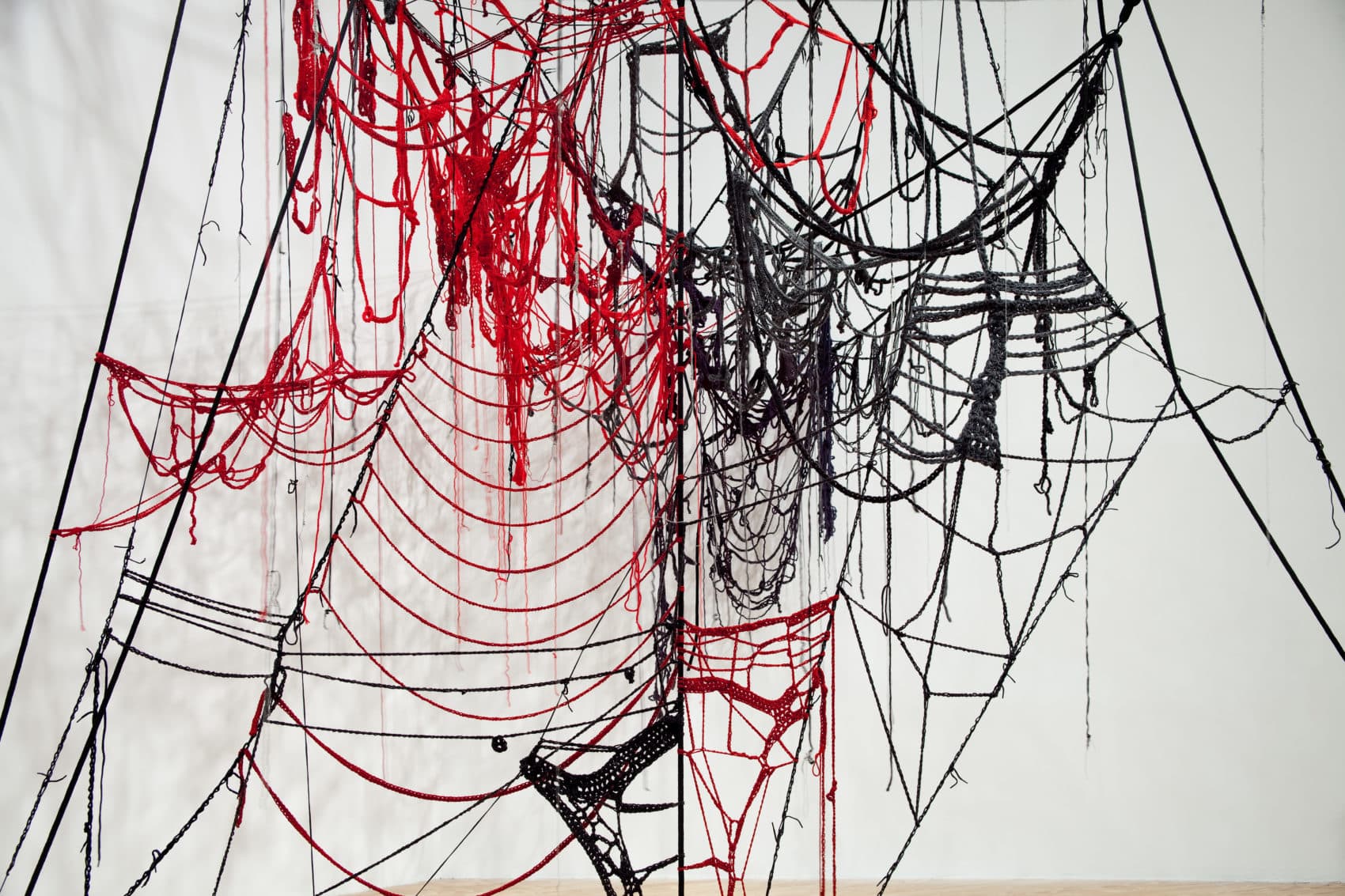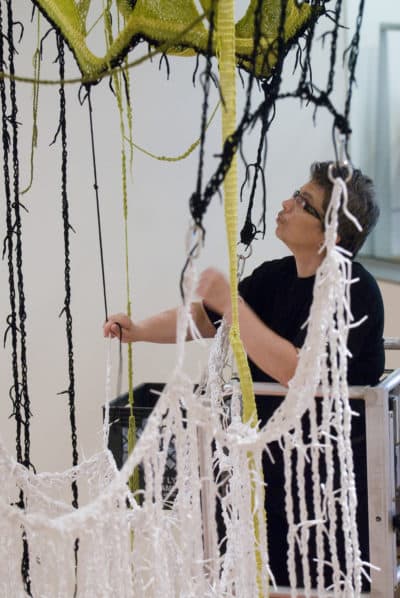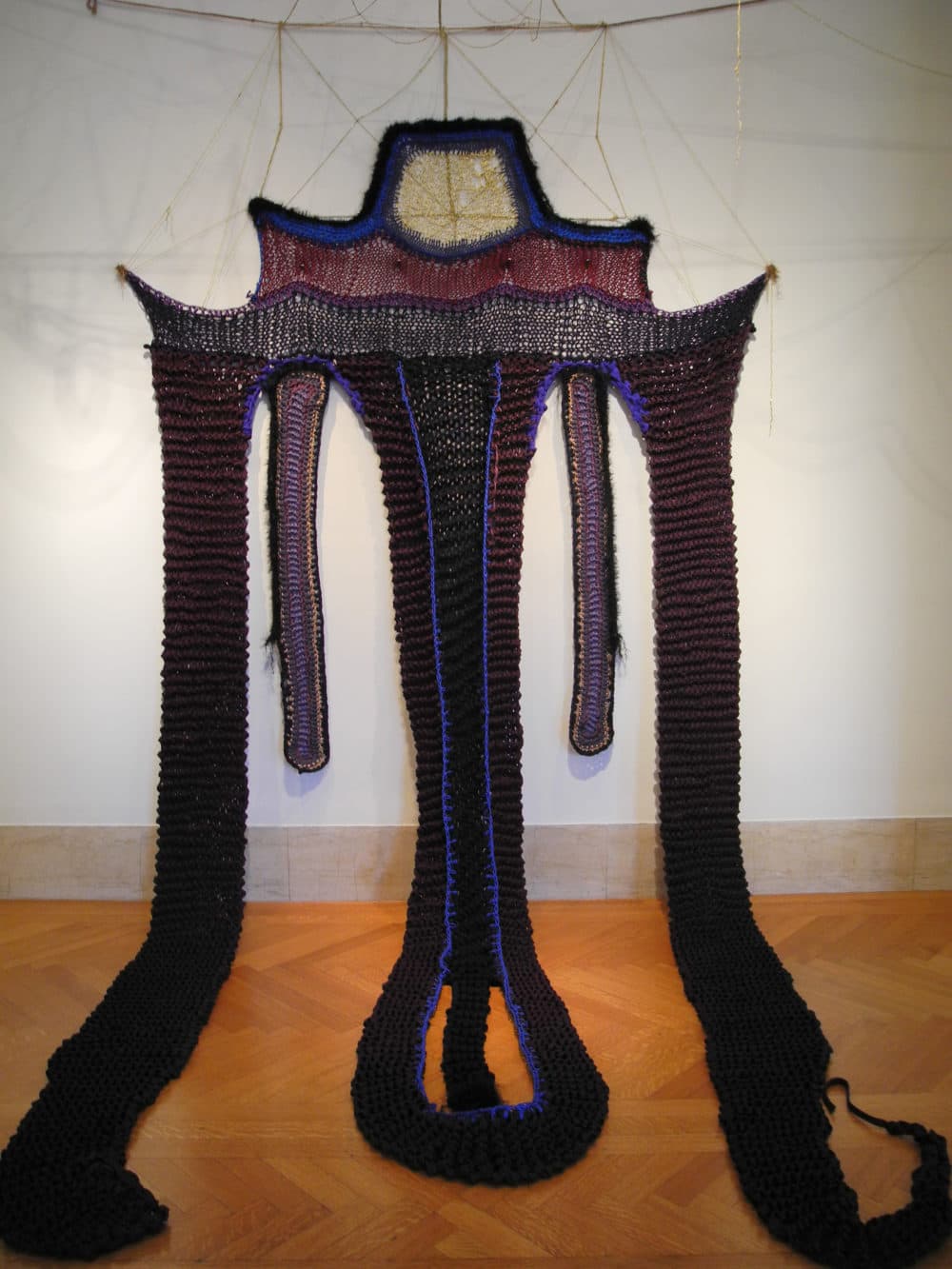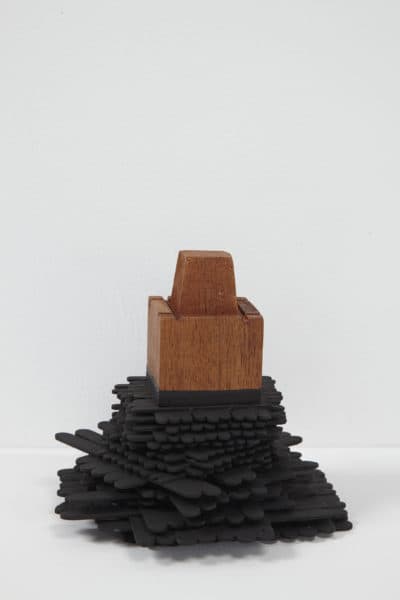Advertisement
Sheila Pepe’s 'Hot Mess Formalism' Coolly And Tidily Defies Categories

Looking at Sheila Pepe's work, the complexity sneaks up on you. You're always looking at two or more categories of art-making at once.
Her sprawling crochet yarn pieces, spun from the ceiling like a spider’s lacey web, are not just fibrous installations. They are sculptures in space and also drawings in space. Or take her smaller-scale objects and sculptures. They can be simultaneously ready-made and handmade. They can be fashioned from most anything at all — fabric, metal, wood, wire. In some exhibitions, Pepe lights them to cast shadows on nearby walls and draws pencil sketches into the shadows, informing and completing the work. There is layer upon layer of form, meaning and context, a web of contrasts, implications and allusions that, in the end, point out how little point there is in drawing up categories to begin with.

“I've always seen the world through having to negotiate, as a really young person, many identities and changing identities,” says Pepe. “No one is reducible to one thing.”
And certainly not Sheila Pepe nor Sheila Pepe’s work.
In “Hot Mess Formalism,” Pepe’s mid-career retrospective opening Oct. 19 at the deCordova Museum, Pepe’s work straddles and stretches through and around its architectural environment, creating ever-changing volumes, lines and spaces. It also straddles mediums — there is drawing, video, ready-made assemblages and handmade sculpture — while reaching beyond classifications of artistic practice, sex and class. Here, things overlap. You can simply look and enjoy what you see, mesmerized by the vast, fishing-net nature of some of her large crochet pieces. How the heck did she get up there? Don’t those blue hanging cords recall a waterfall? Or you can think about the implications of what she’s done by bringing crochet, an activity largely regarded as domestic women’s "craft," into the halls of fine art where the big boys play. Here, “women’s work” is exalted for just one moment, making a statement, perhaps, about museums as institutions of the patriarchy, where art gets codified and historicized for the ages, and where women often get left out of the discussion. And since this work shifts constantly between the formal and conceptual, it says something, too, about art designations. Who says formal art, concerned as it is with the visual look of a piece, is “lower” and less worthy than conceptual “high art,” caught up with grand ideas?
The strength of what Pepe does, says deCordova curator Sarah Montross, is “the degree to which her work calls attention to in-betweenness, whether it's in-between different materials or in-between spaces and things. The fact that it's mutable, the fact that it's flexible.”
“Hot Mess Formalism” traces Pepe’s art over the course of more than 30 years, from the time she lived in Boston as an art student (graduating with a BFA in ceramics from MassArt in 1983 and with an MFA from the Museum School in 1995) all the way up through today, as a successful artist living in Brooklyn with wife Carrie Moyer, a successful abstract artist in her own right. This is the fourth iteration of the exhibit, curated by Gilbert Vicario and first shown at the Phoenix Art Museum in October 2017 (followed by the Everson Museum of Art in Syracuse, New York, in the spring and the Bemis Center for Contemporary Arts in Omaha, Nebraska, last summer).

The exhibit includes more than 70 pieces and meanders between multiple galleries on two floors, crawling down and around walls and through stairwells. The high-impact pieces tend to be Pepe’s large-scale crochet work from more recent years, (pieces like “Put Me Down, Gently” created in 2014 and “Red Hook at Bedford Terrace” created in 2008) incorporating materials with both domestic and industrial associations such as yarn, parachute cord, nautical tow line and shoelaces. But the exhibit also includes pieces like “Women are Bricks,” made in 1983 when Pepe was still at MassArt, as well as a series of what Pepe calls “modern votives” that are smaller scale works combining materials like plaster, fabric, wood, leather and wire.
Pepe’s early work, “Women are Bricks” sets the tone, in many ways, for the years of art practice to follow. That piece is a collection of handmade bricks set on cement rollers sitting on a found rug. The triangular shape of the bricks recalls the outlines of a house, and the grouping and repetition of the bricks recalls a miniature Levittown-like subdivision. The floral carpet places this piece firmly in the domestic realm where somehow the decorative lives incongruously alongside industrial minimalism. In just this one piece, you find neatly summarized the lifetime themes of Pepe’s work — domesticity, fiber, ceramics, craft. The title of the work alludes to women who are mobile, part of all nations but belonging to none.
If this interpretation has a slightly dark edge, rest assured that there is plenty of humor and quirkiness too. Pepe’s “thing” of 1999 is an oil can topped by rubber bands, wires and springs. It exudes a certain whimsical elan. Her “Sewn Hands” of 2005 have a playful feel. Her “Second Vatican Council Wrap” of 2013, a crocheted purple vestment of the sort a pope might wear, is drolly defiant.
Much of her work is intensely autobiographical, so much so that Pepe says that she herself looks to her work for clues about who she is and what she feels.
“At a certain point I learned to read the work,” says Pepe of her pieces. “I could know more things about myself. The work could bring me to new places but also allow a certain kind of reflection.”

Growing up in New Jersey in an Italian Catholic family in the '60s and '70s, Pepe says she realized early on that she lived outside the categories and parameters that had been set forth for her.
“I was raised in a very small environment at home,” she says. “It was very Catholic and very structured, and my days were very structured. My world was my family and my school… I grew up at a time when you got bussed to New York, so you saw some parts of the world through a school bus window that were radically different from your own. And then you went back to your cozy little 1960s and '70s community and life went on.”
Pepe says her family went to Mass every Sunday and confession every Friday night. She went to a Catholic high school and then a Catholic college before attending MassArt. It was expected that she would assimilate into the broader middle-class culture and that she would marry another Catholic. Meanwhile, she says, “I always had a hunch that something else was going on. I was shown another way as I grew older, a way out of roles that were prescribed for me but that I couldn't manage and I didn't know why.”
In college, she found an answer to one problem she had faced in high school. She knew she didn’t like boys because “they were kind of boring.” She could be lesbian. Finally, she had a better understanding of where she fit in the world. In those years, watching John Waters’ movies, reveling in her “otherness,” she felt increasingly liberated from the confines of her strict Catholic upbringing.
Pieces like “Women are Bricks” reflect her developing feminist perspective. After MassArt, Pepe moved into “a house full of lesbians in Allston” and worked in a diner called Beetle’s Lunch, which defined itself as a “lesbian separatist” restaurant. Increasingly, she found herself angry about categories and barriers erected in the arts.
“Art didn’t like Ceramics and Ceramics only liked Clay. And neither liked, or looked like me,” she recounts in the monograph that accompanies the exhibit.

After moving to western Massachusetts and taking a break from art-making, Pepe began to tire of a very different type of dogmatism she was encountering. Growing up, it had been Catholicism. Now, it was rules constructed by lesbian separatists who were themselves critical of Catholic dogma. Their dictums called for eschewing mainstream art, and particularly art shown in patriarchal museums. But Pepe discovered she missed looking at art. And furthermore, she missed making it. She found her way back to art-making, but she also settled on a way of working that would consciously subvert the very institutions showing her work.
The title of the show, “Hot Mess Formalism,” is, according to Pepe, “an homage to my gay brethren.” Woven inextricably as the yarn into Pepe’s work, are ideas about queerness, gender and identity. The title gives a sly nod to an expression common in the black and gay communities referring to something (or someone) who is such a discombobulated wreck they are look absolutely fantastic, too.
Happily, “Hot Mess Formalism” lives up to its name.
“Hot Mess Formalism” is on view at the deCordova Museum from Oct. 19 through March 20, 2019. A curator-led tour will be held Nov. 8 at noon, Pepe will speak at a “Conversation with Sheila Pepe and Nancy Bauer on Thursday Nov. 29 from 6:30 to 8:30 p.m. deCordova is open Wed-Fri, 10 a.m. to 4 p.m. and Sat. and Sun., 10 a.m. to 5 p.m. Admission is $14 for adults, $12 for seniors, $10 for students ages 13 and up and free for children 12 and under.
